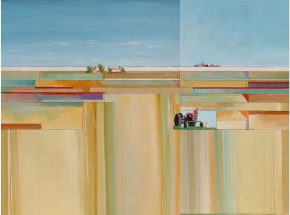

James Weeks was a Bay Area painter whose monumental figural compositions and landscapes from the 1950s and sixties are prized for their clarity, articulation, and balance between color and form.1 Weeks is associated with the Bay Area figurative painters, but unlike his peers—David Park, Elmer Bischoff, and Richard Diebenkorn-he never publicly experimented with non-objective painting, nor did he incorporate sunny landscapes or light-filled interiors into his subject matter. Instead, Weeks’s paintings depict aspects of American culture that hint at a darker, tougher, milieu of nightclubs, jazz singers, and sports arenas. (Weeks’s father was a well-known San Francisco bandleader and his mother was a classical pianist.) A subtle social awareness and concern imbues his work.
Week’s signature, flattened style stands as a significant departure from the gestural paint handling favored by many of his contemporaries. Weeks’s figure drawings also exhibit an economy and deftness of line that evince his dedication to and command of the classical tradition.2 The large, even monumental, size of his paintings, the bold outlining of brilliant color fields, and his use of aggressive, interlocking shapes reflects a broad range of influences, from European modernists Henri Matisse and Max Beckmann to California modernist Maynard Dixon, and the social realism of the great 1930s Mexican muralist Jose Clemente Orozco.
By 1960, Weeks’s unique style had fully emerged and works from this time are highly sought- after by curators and collectors. During this period, he also began painting landscapes, which are prized for their explorations of light and space and the dynamic relationships between color and form. Weeks moved to Los Angeles in 1967 to teach at the University of California, alongside Richard Diebenkorn. Three years later he moved to Massachusetts where he was named the chairman of the Art Department at Boston University. Over the ensuing years, Weeks’s work became more formal and his color more sheer and thinly veiled, as he switched from oil paint to acrylic. He continued to paint landscapes and figurative works, many of which depict chamber musicians, and exhibited in New York City and elsewhere. He died in 1998.
James Weeks’s work is held in many important collections including the Corcoran Gallery, Washington, D.C.; San Francisco Museum of Modern Art; Boston Museum of Art; Oakland Museum of California; and Hirshhorn Museum and Sculpture Garden, Washington, D.C.
http://www.hackettfreedman.com
